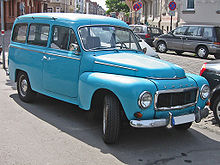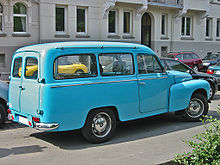Volvo PV445
The Volvo PV445 , also known as the Duett , is the station wagon version of the humpback volvo . In contrast to this, the body of the Duett is not self-supporting, but rests on a frame, the rear axle is leaf-sprung (instead of coil springs). The payload and the ground clearance have been increased. The rear axle ratio was shortened so that the engine and transmission could be taken over from the sedan without any changes, but still able to move larger loads.
Model history
In 1949 a rolling chassis appeared first . The front end was complete up to the approach of the windshield frame, the dashboard was already installed, both of which corresponded to the PV 444 except for small details. Various companies built delivery vans, pickups and even individual convertibles based on this chassis .
In 1952, Volvo began manufacturing a small delivery van itself. On June 4, 1953, the first vehicle was delivered to Volvo co-founder and then director Assar Gabrielsson. The type designation was PV 445 DH (D is the model series, Swedish Herrgårdsvagn is a station wagon with windows).
The name Duett came about when Volvo claimed in its advertising that the car was actually two cars in one ( Bilen som är två ) - a work tool during the day and a family car in the evening and at the weekend.
The duet benefited from all the innovations of the humpback volvo, but sometimes with small delays. Outwardly, it differed from the humpback volvo in a radiator grille with five instead of four ribs, modified decorative strips and first one, later two rear-view mirrors mounted on the fenders.
A new duo based on the PV 544 sedan presented in 1958 did not come onto the market as the P 210 until August 1960. Like the PV 544, it had the one-piece curved windshield, the more modern dashboard of the Volvo Amazon (P 120) with the belt speedometer and, from 1962, the B18 engine with a 12 volt system.
After the PV 544 sedan was discontinued in 1965, production of the duo continued until 1969. The designated successor to the duo, the station wagon version of the Amazon (P 221), had proven to be too small, especially the roof height was significantly lower.
The last duet was built on February 11, 1969, when the successor to the Amazon had been on sale for almost two years, the P 140 .
Its P145 estate version also had significantly less cargo space than the Duett. To compensate for the shortcoming, Volvo presented the P 145 Express model with a raised cargo space roof in 1969 .
The last duet, a royal blue Herrgårdsvagn with chassis number 97299, is now in the Volvo Museum in Gothenburg .
Models
- 1953 - PV 445 DH (Duett Herrgårdsvagn) With side windows and rear bench
- 1953 - PV 445 DS (Duett Skåpvagn) Without side windows and rear bench
- 1955 - PV 445 PH (Personherrgårdsvagn) With a nobler interior than the DH
These three series each had their own type number until 1958, after 1958 only one common. The rolling chassis retained its own type number throughout the entire production period.
- 1960 - P210A with the continuous windshield and dashboard of the PV544 , engine B16A
- March '62 to August '62 P210B with engine B18A and 12 V on-board electrical system (after that there were only detailed changes)
- August '62 to August '63 P210C
- August '63 to August '64 P210D
- August '64 to August '65 P210E
- August '65 to August '66 P210F
- August '66 to August '67 P210M
- August '67 to February '69 P210P
Cabriolet
On the basis of the delivery van chassis of the PV445, around 20 convertibles were manufactured in the early 1950s. The Ringborg and Valbo bodyworks took on roughly equal parts of the production. The fenders, bonnet and bulkhead were delivered from the factory. The rest of the work was done by the body shop. The resulting convertibles cost around twice as much as a hump-PV 444 .






